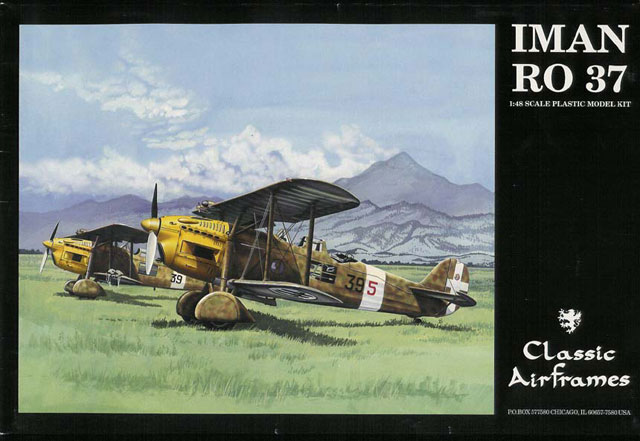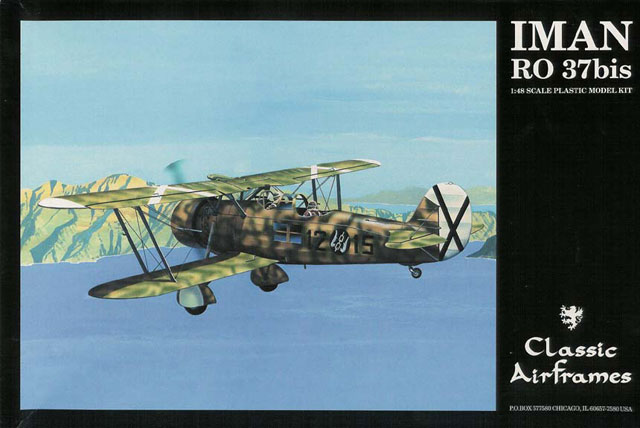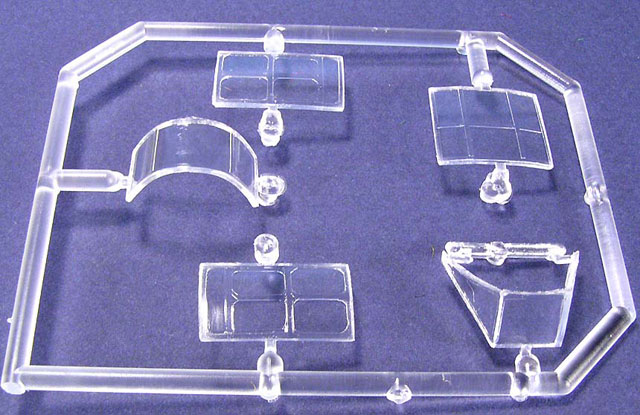|
IMAM Ro.37 & Ro.37bis

Classic Airframes
S u m m a r y
|
|
Catalogue Number: |
Kit Nos. 468 (Ro.37),
469 (Ro.37bis) |
|
Scale: |
1/48 |
| Contents and
Media: |
Kit 468 - 53 parts in gray styrene, 11 parts in cream
colored resin and Kit 469 - 51 parts in grey styrene, 12
parts in cream colored resin. Each kit also has 42 etched
metal parts, 4 printed film, 5 injection molded clear parts,
instructions, decal sheet and painting guide for 3 aircraft.
|
| Price: |
MSRP
USD$50.00 |
| Review Type: |
FirstLook |
| Advantages: |
No one else will produce a model of this aircraft in 1/48
scale! |
| Disadvantages: |
Poor packaging of resin and clear parts; lack of white
background on the national markings and no instructions for
the rigging. |
|
Recommendation: |
Highly Recommended
|
Reviewed by Steven
"Modeldad" Eisenman

Classic Airframes' 1/48 scale Ro.37 and Ro.37bis kits may be ordered
online from Squadron
Jules Bringuier is considered by many to be quite
successful in his Classic Airframes venture.
Usually, when a businessman is successful, he will
go out and buy a new car, or at least a new set of golf clubs. Not
Jules. Success for Jules means being able to bring out a model of
perhaps one of the most unknown combat aircraft of the Second World War
period. Furthermore, its combat role was basically limited to action
against Ethiopia’s and Somalia’s primitive armed forces and during the
Spanish Civil War. I’m looking forward to the numerous postings as to
why Jules did not bring out ………..(fill in the blank) instead of this;
what ever this is.

As to what this thing called an IMAM Ro.37 is,
finding that out is a venture into the great unknown of space.
Basically it is a reconnaissance aircraft that also did duty as a light
bomber. I did, however, stumble across and old on-line article on the
Ro.37 in the Chandelle Journal of Aviation History (
http://www.chandelle-jah.com/
).
http://www.worldatwar.net/chandelle/v4/v4n1-2/ro37.html
My only comment on the article is that I have not
seen any pictures or references to the Ro.37 with the Italian roundels.
By the way, IMAM stands for Industrie
Meccaniche e Aeronautiche Meridionali
Classic Airframes' 1/48 scale Ro.37 kits are nicely
molded in gray styrene and have finely engraved panel lines. The fabric
wings and ribbing detail are also nicely done. There are the usual
injection port pins that must be cleaned up on the inner surfaces of the
wings. The injection gates are, however, quite small for a limited run
kits and there is very little intrusion of the sprue onto the part.
The basic form of the kit is the radial engine
version with the three bladed prop (Kit 469), which includes a very nice
one piece engine. For the inline version with the two blade prop (Kit
468), you will need to do a little surgery, such that you remove the
front of the fuselage by cutting along a panel line just behind the
cooling vents. The inline nose is then attached.

Click
the thumbnails below to view larger images:
The cockpit is sparse, with injection molded
framing for the sides. I’m not sure if this is a criticism, as I don’t
believe I have ever seen a picture of the cockpits of this aircraft. I
would also tend to believe that it would be quite sparse. The Ro.37 was
not exactly high-tech in its time.
The clear parts are nicely molded with prominent
frame lines to aid in masking. They are also quite clear, and will get
even better with a bath in Future.

Click
the thumbnails below to view larger images:
For those who love working with photo etched parts,
these kits should make your day. There are multiple pieces to make up
the Italian chain and strap style harness. Also, as this aircraft had
spoke wheels, whether or not it had the wheel covers, you get full sets
of wheel spokes.
Each kit comes with markings and painting guide for
three aircraft. Note: Many of the aircraft had the topside camouflage
wrap around the underside with only the underside of the wings,
including the bottom wing center section in the underside gray color.
Kit 468 - Ro.37
-
39-9 of 39
Squadriglia, 5 Gruppo, Venaria Reale, Italy, circa June 1940 – This
aircraft is in a wavy pattern of Giallo (Yellow - FS 33434), Verde
(Green - FS34092) and Bruno (Brown - FS30076) Mimetico with Gigio
Mimetico (Gray - FS36307) undersides of the wings.
-
25-7 of 37
Squadriglia, 72 Gruppo, 19 Stormo, Coritza, circa 1941 – This
aircraft has a base color of Giallo with splotches of Verde and
Bruno Mimetico. Wing undersides are Grigio.
-
39-5 of 39
Squadriglia, 5 Gruppo, 39 Stormo, Scutari, Montenegro, circa 1942.
This is the aircraft on the box cover, and the color picture of the
line up of this group of Ro.37 is often seen in publications. This
aircraft has a Verde base color with random splotches of Giallo and
Bruno. Wing undersides are Grigio. The nose is Giallo Cromo (Chrome
Yellow – FS 33655 is a close match).
Click
the thumbnails below to view larger images:
Kit 469 – Ro.37bis
-
115-6 of 115
Squadriglia O. A., Tament, North Africa, circa October 1940. This
aircraft is in a Giallo base color with Verde splotches. The full
underside is in Grigio Mimetico.
-
12*15 of Grupo
4-G-12, Spanish Nationalist Air Force, circa 1938. This aircraft is
in a free style application of Giallo and Verde Mimetico. The
underside is Grigio. On the cowl are the words “ALF F. SUAREZ
PRESENTE”. This was the aircraft of Commander Manuel Negron de
las Cuevas. The inscription is to remember “Alferez” Andres
Fernandez Suarez a pupil in a flight school who was killed in a
landing accident. Note: The Nationalist Air Force often painted the
propeller in the camouflage colors and pattern of the fuselage,
while I do not know if this particular aircraft had its propeller so
painted, pictures of other Ro.37bis indicate that the practice was
common.
-
“Domino” 10 of XXVI
Gruppo, 105 Squadriglia, Ethiopia, circa 1935. This is the most
problematic set of marking, and clearly included out of love for
this aircraft. The Ro.37 in Ethiopia were painted Bianco Avorio
(Ivory White – FS33613) [Technically, prior to 1940 it was known as
Cachi Avorio Chiaro – Light Ivory Kaki, but this description is not
commonly used]. The color had a slight pink component when new, but
faded under the sun to FS 33690, losing its pink tint. On the top
of the upper wing were radiating bands of red, presumably for aiding
in finding a lost aircraft in the vast expanse of wasteland. The
fuselage had a bright green band, and on it was the aircraft’s
number represented by a white domino with black dots. The rudder
carried the Italian tricolor. The reason this particular aircraft
is a problem is that the fuselage from the cockpit back is quite
different from the later Ro.37bis, as represented by the kit. The
painting guide gives brief instructions on making the conversion.
But, be warned, it will require a bit of work. It also had a two
bladed prop, rather than the later three bladed prop. Considering
that very few people, if any, could identify an Ethiopian based
Ro.37, and considering how lovely the scheme is, I might just do one
straight from the box, changing only the prop.
Click
the thumbnails below to view larger images:
I do have three criticisms: 1. The clear parts are
packed with all the other plastic parts, which can cause scratching.
2. The instruction do not provide a rigging diagram. 3. I hate using
cut out masks for the white background on the Italian markings ( I keep
a good supply of Italian marking for just this reason.).
Also, please note that the box refers to the
aircraft as IMAN RO 37 and RO 37bis, whereas they should be labeled IMAM
Ro.37 and Ro.37bis.
I am sure many of you are thinking “… of course
Modeldad likes these kits, he has a thing for odd ball aircraft and he
is a bit odd himself.”
Truth be told, you’d be correct.
But even so, it is very nice to have something
quite different come along, especially as the Ro.37 was part of the last
of a breed - bi-planes used in combat.
The Ro.37 will look good alongside my Cr 32, and
42, Hs 123, Ar 68 and Gladiator.
Highly Recommended.
-
Ali Italiane in Africa
Orientale 1935 – 1940; Carlo Lucchini; AES Albertelli Edizione
Speciali “STORIA militare”; Parma; 1997. (OOP)
-
Regia Aeronautica Caccia
& Assalto 1940-1943; Pt. I and II; P. Waldis & M. De Bortoli; La
Bancarella Aeronautica; Torino; 2002.
-
Wings Over Spain; A.
Emiliani & G. Ghergo; Giorgio Apostolo Editore; Milano; 1997.
Thanks to
Classic Airframes for
the review sample.
Classic
Airframes kits are available worldwide through hobby retailers and from
Squadron.com
Review and Images Copyright © 2004 by
Steven Eisenman
Page Created 12 October, 2004
Last updated 29 October, 2004
Back to HyperScale Main Page
Back to Reviews Page
|
Home | What's
New | Features
| Gallery |
Reviews | Reference
| Forum
| Search